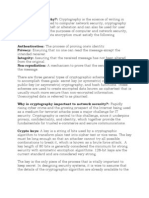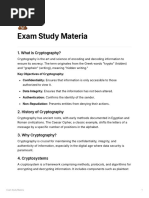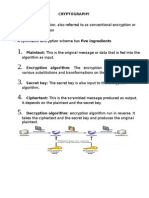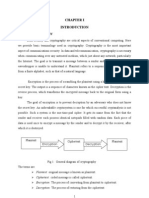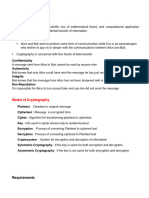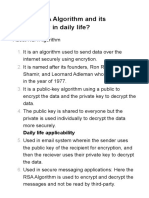7 Data Encryption and Decryption Data Encryption Standard Algorithm
Uploaded by
aswanth00157 Data Encryption and Decryption Data Encryption Standard Algorithm
Uploaded by
aswanth0015Exp. No.
: 7 Data encryption and decryption using
Date : Data Encryption Standard algorithm
AIM :
To write a C program to implement Data encryption and decryption using Data
Encryption Standard algorithm.
HARDWARE / SOFTWARE REQUIREMENTS:
Personal Computer
Turbo C compiler
THEORY:
Cryptography is the practice and study of techniques for secure communication in the presence
of third parties (called adversaries). More generally, it is about constructing and analyzing protocols that
overcome the influence of adversaries and which are related to various aspects in information security
such as data confidentiality, data integrity, authentication, and non-repudiation.
In cryptography, encryption is the process of encoding messages in such a way that third parties
cannot read it, but only authorized parties can. Encryption doesn't prevent hacking but it prevents the
hacker from reading the data that is encrypted. In an encryption scheme, the message or information is
encrypted using an encryption algorithm, turning it into an unreadable cipher text. This is usually done
with the use of an encryption key, which specifies how the message is to be encoded. Any adversary
that can see the cipher text should not be able to determine anything about the original message. An
authorized party, however, is able to decode the cipher text using a decryption algorithm, that usually
requires a secret decryption key that adversaries do not have access to. For technical reasons, an
encryption scheme usually needs a key- generation algorithm to randomly produce keys.
Kinds of encryption
Symmetric key encryption
Symmetric-key algorithms are a class of algorithms for cryptography that use the same
cryptographic keys for both encryption of plaintext and decryption of cipher text. The keys may be
identical or there may be a simple transformation to go between the two keys. The keys, in practice,
represent a shared secret between two or more parties that can be used to maintain a private information
link. This requirement that both parties have access to the secret key is one of the main drawbacks of
symmetric key encryption, in comparison to public-key encryption. This is also known as private key
encryption. In Symmetric-key schemes, the encryption and decryption keys are the same. Thus,
communicating parties must agree on a secret key before they wish to communicate.
Networks and Security Lab
Public key encryption
Public-key cryptography, also known as asymmetric cryptography, refers to a cryptographic
algorithm which requires two separate keys, one of which is secret (or private) and one of which is
public. Although different, the two parts of this key pair are mathematically linked. The public key is
used to encrypt plaintext or to verify a digital signature; whereas the private key is used to decrypt
cipher text or to create a digital signature. The term "asymmetric" stems from the use of different keys
to perform these opposite functions, each the inverse of the other – as contrasted with conventional
("symmetric") cryptography which relies on the same key to perform both. In public-key encryption
schemes, the encryption key is published for anyone to use and encrypt messages. However, only the
receiving party has access to the decryption key and is capable of reading the encrypted messages.
Working principle:
In cryptography, RC4 is the most widely used software stream cipher and is used in popular protocols
such as Transport Layer Security (TLS) (to protect Internet traffic) and WEP (to secure wireless
networks). While remarkable for its simplicity and speed in software, RC4 has weaknesses that argue
against its use in new systems. It is especially vulnerable when the beginning of the output key stream is
not discarded, or when nonrandom or related keys are used; some ways of using RC4 can lead to very
insecure cryptosystems such as WEP.
Networks and Security Lab
This stream cipher was invented in 1987 by Ron Rivest, one of the inventors of the RSA public
key cryptography algorithm and co-founders of RSA security. Even though the RC4 cipher is named as
"Rivest Cipher 4".
ALGORITHM-ENCRYPTION
Get the text to be encrypted (plain text) and key text.
a. Find the length of the plain text.
b. For i=1 to length of plain text
c. Find the binary equivalent of ith character of plain text.
d. Find the binary equivalent of ith character of key text
e. Find the XOR of above two values.
The resulting value will be the encrypted format (cipher text) of the plain text.
ALGORITHM-DECRYPTION
Get the text to be decrypted (cipher text) and key text.
Find the length of the cipher text.
For i=1 to length of cipher text
a. Find the binary equivalent of ith character of cipher text.
b. Find the binary equivalent of ith character of key text
c. Find the XOR of above two values.
The resulting value will be the decrypted format (original plain text) of the cipher plain text.
Program:
#include <stdio.h>
int main()
{
int i, x;
char str[100];
printf("\nPlease enter a string:\t");
gets(str);
Networks and Security Lab
printf("\n Please choose following options:\n");
printf("1 = Encrypt the string.\n");
printf("2 = Decrypt the string.\n");
scanf("%d", &x);
//using switch case statements
switch(x)
{
case 1:
for(i = 0; (i < 100 && str[i] != '\0'); i++)
str[i] = str[i] + 3; //the key for encryption is 3 that is added to ASCII value
printf("\nEncrypted string: %s\n", str);
break;
case 2:
for(i = 0; (i < 100 && str[i] != '\0'); i++)
str[i] = str[i] - 3; //the key for encryption is 3 that is subtracted to ASCII value
printf("\nDecrypted string: %s\n", str);
break;
default:
printf("\nError\n");
}
return 0;
}
Networks and Security Lab
OUTPUT:
Networks and Security Lab
RESULT:
Thus the implementation of Data encryption and decryption using Data Encryption
Standard algorithm is executed and the output is obtained successfully.
Networks and Security Lab
You might also like
- Hourglass Workout Program by Luisagiuliet 276% (21)Hourglass Workout Program by Luisagiuliet 251 pages
- The Hold Me Tight Workbook - Dr. Sue Johnson100% (16)The Hold Me Tight Workbook - Dr. Sue Johnson187 pages
- Read People Like A Book by Patrick King-Edited62% (66)Read People Like A Book by Patrick King-Edited12 pages
- Livingood, Blake - Livingood Daily Your 21-Day Guide To Experience Real Health77% (13)Livingood, Blake - Livingood Daily Your 21-Day Guide To Experience Real Health260 pages
- COSMIC CONSCIOUSNESS OF HUMANITY - PROBLEMS OF NEW COSMOGONY (V.P.Kaznacheev,. Л. V. Trofimov.)94% (212)COSMIC CONSCIOUSNESS OF HUMANITY - PROBLEMS OF NEW COSMOGONY (V.P.Kaznacheev,. Л. V. Trofimov.)212 pages
- Donald Trump & Jeffrey Epstein Rape Lawsuit and Affidavits83% (1016)Donald Trump & Jeffrey Epstein Rape Lawsuit and Affidavits13 pages
- The 36 Questions That Lead To Love - The New York Times94% (34)The 36 Questions That Lead To Love - The New York Times3 pages
- The 36 Questions That Lead To Love - The New York Times95% (21)The 36 Questions That Lead To Love - The New York Times3 pages
- Jeffrey Epstein39s Little Black Book Unredacted PDF75% (12)Jeffrey Epstein39s Little Black Book Unredacted PDF95 pages
- The 4 Hour Workweek, Expanded and Updated by Timothy Ferriss - Excerpt23% (954)The 4 Hour Workweek, Expanded and Updated by Timothy Ferriss - Excerpt38 pages
- 3.5.1 Asymmetric Keys and Encryption MethodsNo ratings yet3.5.1 Asymmetric Keys and Encryption Methods5 pages
- Using Cryptography Algorithms To Secure Cloud Computing Data and ServicesNo ratings yetUsing Cryptography Algorithms To Secure Cloud Computing Data and Services4 pages
- 35fb5340 b870 4exam - Study - Materia 111No ratings yet35fb5340 b870 4exam - Study - Materia 11129 pages
- Network Security & Cryptography - Unit-1No ratings yetNetwork Security & Cryptography - Unit-111 pages
- Methods Toward Enhancing Rsa Algorithm: A SurveyNo ratings yetMethods Toward Enhancing Rsa Algorithm: A Survey18 pages
- The Use of Elliptic Curves in Cryptography: Aster S Hesis in AthematicsNo ratings yetThe Use of Elliptic Curves in Cryptography: Aster S Hesis in Athematics76 pages
- IT1352 Cryptography and Network SecurityNo ratings yetIT1352 Cryptography and Network Security29 pages
- Unit - Ii: Traditional Symmetric-Key CiphersNo ratings yetUnit - Ii: Traditional Symmetric-Key Ciphers124 pages
- Implementation of Aes and Blowfish AlgorithmNo ratings yetImplementation of Aes and Blowfish Algorithm4 pages
- Chapter 5 Authentication and Encryption TechnologyNo ratings yetChapter 5 Authentication and Encryption Technology34 pages
- Cryptography: Joemari Saysay Sabao, MitNo ratings yetCryptography: Joemari Saysay Sabao, Mit17 pages
- Cryptography Basics for New Coders: A Practical Guide with ExamplesFrom EverandCryptography Basics for New Coders: A Practical Guide with ExamplesNo ratings yet
- A Hands-On Approach To Linux Privilege Escalation: Tanishq Sharma, Shikhar SaxenaNo ratings yetA Hands-On Approach To Linux Privilege Escalation: Tanishq Sharma, Shikhar Saxena14 pages
- BRA Symmetric Encryption Algorithm: Remzi AKTAYNo ratings yetBRA Symmetric Encryption Algorithm: Remzi AKTAY4 pages
- Cyber Crime & Cyber Security - TutorialspointNo ratings yetCyber Crime & Cyber Security - Tutorialspoint2 pages
- Com - Res - 11045 - AnnexL Authority To File COCNo ratings yetCom - Res - 11045 - AnnexL Authority To File COC1 page
- Final Exam - Evaluación Final - Cybersecurity Essentials46% (50)Final Exam - Evaluación Final - Cybersecurity Essentials32 pages
- Lesson 2 Security Threats and VulnerabilitiesNo ratings yetLesson 2 Security Threats and Vulnerabilities12 pages
- السلطة-الوطنية-لحماية-المعطيات-ذات-الطابع-الشخصي-كآلية-لحماية-الحق-في-الخصوصية-في-ظل-القانون-18-07.No ratings yetالسلطة-الوطنية-لحماية-المعطيات-ذات-الطابع-الشخصي-كآلية-لحماية-الحق-في-الخصوصية-في-ظل-القانون-18-07.12 pages
- Computer Security and Privacy: COSC 624No ratings yetComputer Security and Privacy: COSC 62439 pages
- HTTP WWW - Aphref.aph - Gov.au House Committee Laca Crimeinthecommunity Subs Sub44nNo ratings yetHTTP WWW - Aphref.aph - Gov.au House Committee Laca Crimeinthecommunity Subs Sub44n33 pages
- Livingood, Blake - Livingood Daily Your 21-Day Guide To Experience Real HealthLivingood, Blake - Livingood Daily Your 21-Day Guide To Experience Real Health
- COSMIC CONSCIOUSNESS OF HUMANITY - PROBLEMS OF NEW COSMOGONY (V.P.Kaznacheev,. Л. V. Trofimov.)COSMIC CONSCIOUSNESS OF HUMANITY - PROBLEMS OF NEW COSMOGONY (V.P.Kaznacheev,. Л. V. Trofimov.)
- Donald Trump & Jeffrey Epstein Rape Lawsuit and AffidavitsDonald Trump & Jeffrey Epstein Rape Lawsuit and Affidavits
- The 36 Questions That Lead To Love - The New York TimesThe 36 Questions That Lead To Love - The New York Times
- The 36 Questions That Lead To Love - The New York TimesThe 36 Questions That Lead To Love - The New York Times
- Jeffrey Epstein39s Little Black Book Unredacted PDFJeffrey Epstein39s Little Black Book Unredacted PDF
- The 4 Hour Workweek, Expanded and Updated by Timothy Ferriss - ExcerptThe 4 Hour Workweek, Expanded and Updated by Timothy Ferriss - Excerpt
- Using Cryptography Algorithms To Secure Cloud Computing Data and ServicesUsing Cryptography Algorithms To Secure Cloud Computing Data and Services
- The Use of Elliptic Curves in Cryptography: Aster S Hesis in AthematicsThe Use of Elliptic Curves in Cryptography: Aster S Hesis in Athematics
- Chapter 5 Authentication and Encryption TechnologyChapter 5 Authentication and Encryption Technology
- Application and Implementation of DES Algorithm Based on FPGAFrom EverandApplication and Implementation of DES Algorithm Based on FPGA
- Cryptography Basics for New Coders: A Practical Guide with ExamplesFrom EverandCryptography Basics for New Coders: A Practical Guide with Examples
- Encryption Demystified The Key to Securing Your Digital LifeFrom EverandEncryption Demystified The Key to Securing Your Digital Life
- A Hands-On Approach To Linux Privilege Escalation: Tanishq Sharma, Shikhar SaxenaA Hands-On Approach To Linux Privilege Escalation: Tanishq Sharma, Shikhar Saxena
- Final Exam - Evaluación Final - Cybersecurity EssentialsFinal Exam - Evaluación Final - Cybersecurity Essentials
- السلطة-الوطنية-لحماية-المعطيات-ذات-الطابع-الشخصي-كآلية-لحماية-الحق-في-الخصوصية-في-ظل-القانون-18-07.السلطة-الوطنية-لحماية-المعطيات-ذات-الطابع-الشخصي-كآلية-لحماية-الحق-في-الخصوصية-في-ظل-القانون-18-07.
- HTTP WWW - Aphref.aph - Gov.au House Committee Laca Crimeinthecommunity Subs Sub44nHTTP WWW - Aphref.aph - Gov.au House Committee Laca Crimeinthecommunity Subs Sub44n















































